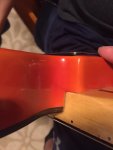jimistone
long standing member
I start with 400 grit (smooths out the file marks) and follow with 1000 (smooths out the tiny 400 grit scratches) and finally 1500 grit (polishes out the microscopic 1000 grit scratches).This is pretty much the process I planned to use since I have that triangle file, sandpaper, tape, and a marker. I'm not sure how fine a grit I have...he uses the micro mesh stuff which is really fine.
YouTube
Do you think that's fine for just doing a handful of frets?
PS. Philadelphia luthier supply has good tools at good prices. Same quality as stewmac at like half the price.
Finally I go over them with very fine steel wool and polish with a dremmel tool and machine polish.
bear in mind this is FAR beyond what is done to the frets of 90% of brand spanking new guitars. So, it may be overkill on a $10 guitar.
I would probably try to match the finish level the rest of the frets are at on that one





